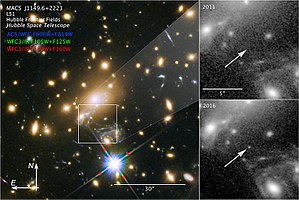MACS J1149 Lensed Star 1
 Detection of MACS J1149 Lensed Star 1 A galactic cluster (left) magnified a distant star (now named Icarus) more than 2,000 times, making it visible in 2016 from Earth (lower right), 9.34 billion light-years away—although visible in 2016, the star was not visible in 2011 (upper right). | |
| Observation data J2000[1]
| |
|---|---|
| Constellation | Leo[1][2] |
| Right ascension | 11h 49m 35.59s[1] |
| Declination | 22° 23′ 47.4″[1] |
comoving distances of 14.4 billion ly | |
| Characteristics | |
| Spectral type | B[2] |
| Apparent magnitude (V) | ≈28.4[2] (normally 29.9)[note 1] |
| Apparent magnitude (R) | ≈28.2[2] (normally 29.7) |
| Apparent magnitude (Z) | ≈27.9[2] (normally 29.4) |
| Apparent magnitude (J) | 27.3[2] (normally 28.8) |
| Apparent magnitude (H) | 27.4[2] (normally 28.9) |
| Details | |
Myr | |
| Other designations | |
Icarus, LS1, MACS J1149 LS1, MACS J1149 Lensed Star 1 (LS1), MACS J1149+2223 Lensed Star 1 | |
MACS J1149 Lensed Star 1, also known as Icarus,
History
In April and May 2018,[2] the star was found in the course of studying the supernova SN Refsdal with the Hubble Space Telescope. Astronomer Patrick Kelly of the University of Minnesota is the lead author of the finding, published in the journal Nature Astronomy.[2][8]
While astronomers had been collecting images of this supernova from 2004 onward, they recently discovered a point source that had appeared in their 2013 images, and become much brighter by 2016. They determined that the point source was a solitary star being magnified more than 2,000 times by
The light observed from the star was emitted when the universe was about 30% of its current age of 13.8 billion years. Kelly suggested that similar microlensing discoveries could help them identify the earliest stars in the universe.[11]
Name
The formal name MACS J1149 is a reference to MAssive Cluster Survey and the star's coordinates in the J2000 astronomical epoch.
While Kelly had wanted to name the star Warhol, alluding to Andy Warhol's notion of having 15 minutes of fame, the team ended up naming the star Icarus based on the Greek mythological figure.[8]
Astrophysical implications
The discovery shows that astronomers can study the oldest stars in background galaxies of the early universe by combining the strong gravitational lensing effect from galaxy clusters with gravitational microlensing events caused by compact objects in these galaxy clusters.[2][12] By using these events, astronomers can study and test some models about dark matter in galaxy clusters and observe high energy events (supernovae, variable stars) in young galaxies.[9][12][13]
See also
Notes
- ^ The microlensing event brightened the star by a factor of 4, or about 1.5 magnitudes. With 600× magnification, it is brightened by 6002 (360,000), which would be an additional magnitude difference of 13.9 magnitudes. Therefore, the star would have Vmag of 43.8 without any lensing effects, thousands of times dimmer than any current or planned telescopes can see.
- ^ Other names include LS1, MACS J1149 LS1, MACS J1149 Lensed Star 1 (LS1) and MACS J1149+2223 Lensed Star 1
References
- ^ S2CID 206633888.
- ^ S2CID 125826925.
- Wolfram Alpha. Retrieved 4 April 2018.
- ^ a b c Jenkins, Ann; Villard, Ray; Kelly, Patrick (2 April 2018). "Hubble Uncovers the Farthest Star Ever Seen". NASA. Retrieved 2 April 2018.
- ^ a b Howell, Elizabeth (2 April 2018). "Rare Cosmic Alignment Reveals Most Distant Star Ever Seen". Space.com. Retrieved 2 April 2018.
- ^ a b Sanders, Robert (2 April 2018). "Hubble peers through cosmic lens to capture most distant star ever seen". Berkeley News. Retrieved 2 April 2018.
- ^ a b c d e Parks, Jake (2 April 2018). "Hubble spots farthest star ever seen". Astronomy. Retrieved 2 April 2018.
- ^ a b c Dunham, Will (2 April 2018). "Most distant star ever detected sits halfway across the universe". Reuters. Retrieved 3 April 2018.
- ^ S2CID 55811307.
- ^ "Hubble uses cosmic lens to discover most distant star ever observed". Hubble Space Telescope. 2 April 2018. Retrieved 3 April 2018.
- ^ a b Guarino, Ben (3 April 2018). "This star is the farthest ever seen. It's 9 billion light-years away". The Washington Post.
- ^ a b Rosanne Di Stefano (2 April 2018). "Cosmic flashing lights". Nature Astronomy. Retrieved 6 April 2018.
- S2CID 119369406.
External links
- Hubble Discovers Supernova Split by Cosmic Lens – NASA (2017)
- View of SN Refsdal – National Geographic Society (2015)
- Images of SN Refsdal – HubbleSite(2015)
- Hubble Uncovers the Farthest Star Ever Seen (2018)


